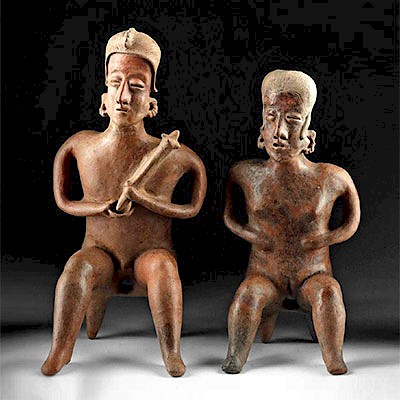Two Matching Huari Polychrome Textile Panels - Jaguars
Lot 126c
About Seller
Artemis Fine Arts
686 S Taylor Ave, Ste 106
Louisville, CO 80027
United States
Selling antiquities, ancient and ethnographic art online since 1993, Artemis Gallery specializes in Classical Antiquities (Egyptian, Greek, Roman, Near Eastern), Asian, Pre-Columbian, African / Tribal / Oceanographic art. Our extensive inventory includes pottery, stone, metal, wood, glass and textil...Read more
Estimate:
$3,500 - $4,500
Absentee vs Live bid
Two ways to bid:
- Leave a max absentee bid and the platform will bid on your behalf up to your maximum bid during the live auction.
- Bid live during the auction and your bids will be submitted real-time to the auctioneer.
Bid Increments
| Price | Bid Increment |
|---|---|
| $0 | $25 |
| $300 | $50 |
| $1,000 | $100 |
| $2,000 | $250 |
| $5,000 | $500 |
| $10,000 | $1,000 |
| $20,000 | $2,500 |
| $50,000 | $5,000 |
| $100,000 | $10,000 |
| $200,000 | $20,000 |
About Auction
By Artemis Fine Arts
May 23, 2019
Set Reminder
2019-05-23 10:00:00
2019-05-23 10:00:00
America/New_York
Bidsquare
Bidsquare : Exceptional Day 2 Ethnographic Tribal Fossils
https://www.bidsquare.com/auctions/artemis-gallery/exceptional-day-2-ethnographic-tribal-fossils-4136
Day 2 of an important 2-day auction featuring exceptional ethnographic art from around the world. Today's sale will feature Pre-Columbian from the ancient americas, Native American, African / Tribal, Oceanic, Spanish Colonial, and incredible Fossils. Artemis Fine Arts info@artemisfinearts.com
Day 2 of an important 2-day auction featuring exceptional ethnographic art from around the world. Today's sale will feature Pre-Columbian from the ancient americas, Native American, African / Tribal, Oceanic, Spanish Colonial, and incredible Fossils. Artemis Fine Arts info@artemisfinearts.com
- Lot Description
Pre-Columbian, South Coast Peru, Wari (Huari) culture, ca. 700 to 1000 CE. A fabulous pair of colorful textile panels comprised of tightly-woven natural camelid (llama or alpaca wool) fibers in hues of ruby, emerald, fuchsia, wheat, citrine, cobalt, jet, and pearl. Each panel contains four abstract jaguars surrounded by concentric square frames with vibrant stepped motifs within the borders. Each feline figure boasts a sinuous body with a curling tail, stocky limbs with delineated claws, and rough triangular heads with rectangular eyes, gaping mouths, and tiered headdresses. The serpentine form emitted from each jaguar mouth is representative of the "life force" the jaguar steals from each animal it consumes. A fine set of textiles replete with expert artistic stylization and a wonderful chromatic palette! Mounted on fabric backing. Size of largest (white upper border): 4.875" W x 18.75" H (12.4 cm x 47.6 cm); size (fabric backing): 28" W x 34" H (71.1 cm x 86.4 cm).
The jaguar symbolized power and might throughout the Pre-Columbian world. Warriors, rulers, hunters, and shamans alike associated themselves with this king of beasts, the largest and most powerful feline in the New World. Furthermore, the principal god of the earlier Moche wears a headdress adorned with a jaguar head and paws, and important mortals donned similar headdresses. The Huari, having assumed much of the territory of the earlier Moche peoples, were most likely influenced by the Moche's practices and beliefs when concerning the deep symbolism of jaguars.
A nocturnal animal, the jaguar sleeps in caves and dark places, creeps quietly along the forest floor as well as in the trees, and evokes great mystery. So, oddly enough, few Moche and Huari artists would have actually seen jaguars as they are not indigenous to Peruvian coastal regions; jaguars prefer moist forest conditions. However, scholars believe that some jaguar cubs were transported over the mountains for Moche rituals, and it is also possible that some jaguars were seen when they wandered down the coast.
Provenance: private Hawaii, USA collection; ex-Eugene Lions collection, Geneva, Switzerland
All items legal to buy/sell under U.S. Statute covering cultural patrimony Code 2600, CHAPTER 14, and are guaranteed to be as described or your money back.
A Certificate of Authenticity will accompany all winning bids.
We ship worldwide and handle all shipping in-house for your convenience.
#138988Light restoration to middle-right periphery of smaller textile. Both textiles have minor loosening and fraying to interior and peripheral threads, and some fading and light staining to coloration.Condition
- Shipping Info
-
All shipping is handled in-house for your convenience. Your invoice from Artemis Gallery will include shipping calculation instructions. If in doubt, please inquire BEFORE bidding for estimated shipping costs for individual items.
-
- Buyer's Premium



 EUR
EUR CAD
CAD AUD
AUD GBP
GBP MXN
MXN HKD
HKD CNY
CNY MYR
MYR SEK
SEK SGD
SGD CHF
CHF THB
THB















